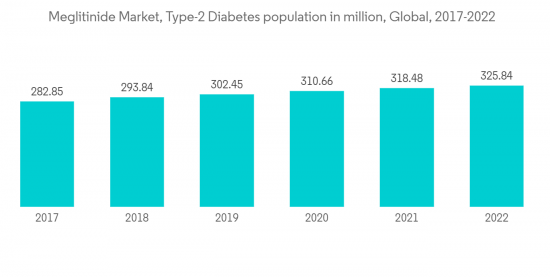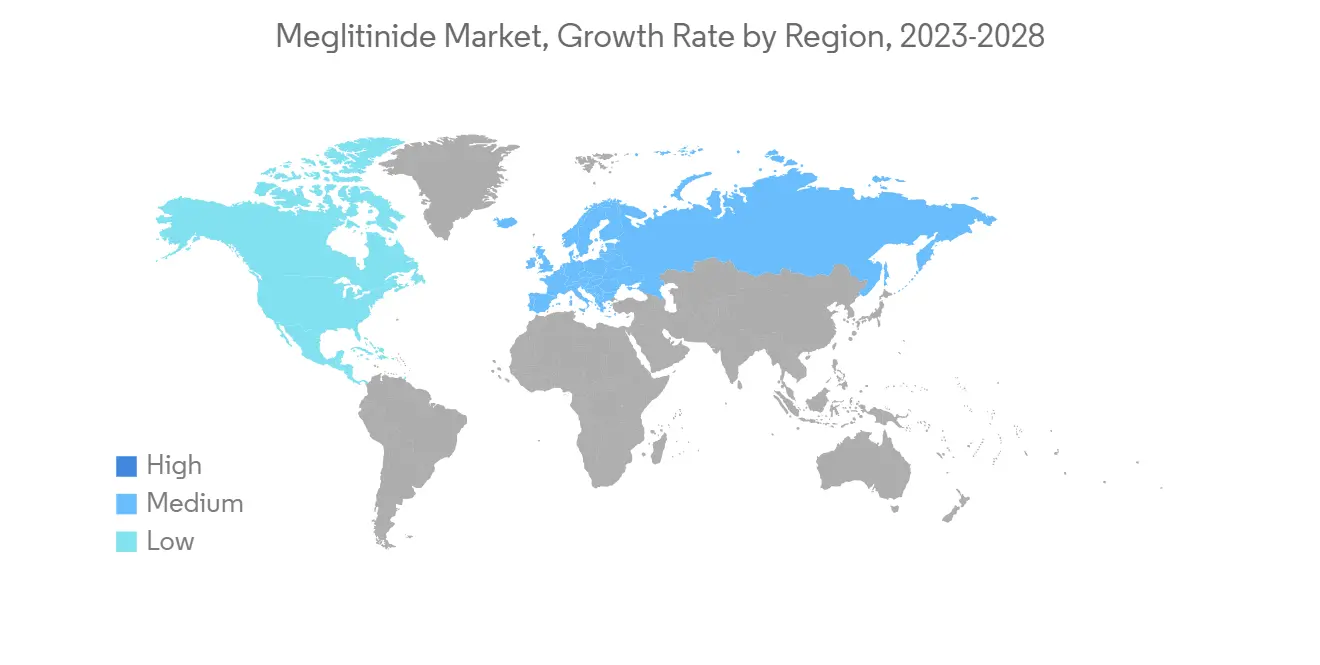PUBLISHER: Mordor Intelligence | PRODUCT CODE: 1332490

PUBLISHER: Mordor Intelligence | PRODUCT CODE: 1332490
Meglitinide Market Size & Share Analysis - Growth Trends & Forecasts (2023 - 2028)
The Meglitinide Market size is estimated at USD 4.15 billion in 2023, and is expected to reach USD 4.63 billion by 2028, growing at a CAGR of 2.21% during the forecast period (2023-2028).
The market is estimated to reach a value of more than USD 4.5 billion by 2027.
The COVID-19 pandemic has had a substantial impact on the Meglitinide market. The prevalence of diabetes in people hospitalized with COVID-19 infection and the recognition that improved glycemic control might improve outcomes and reduce the length of stay in patients with SARS-CoV-2 have underlined the importance of the anti-diabetic drugs market. People with diabetes have a weaker immune system, the COVID-19 complication aggravates the condition, and the immune system gets weaker very fast. Diabetes and uncontrolled hyperglycemia are risk factors for poor outcomes in patients with COVID-19 including an increased risk of severe illness or death. Thus, the COVID-19 outbreak increased the meglitinide market's growth globally.
Meglitinides are a class of non-sulfonylurea insulin secretagogues characterized by very rapid onset and shorter duration of action. They stimulate first-phase insulin release in a glucose-sensitive manner, reducing the risk of hypoglycemic events. People with type 2 diabetes have chronically high blood sugar levels and meglitinides make the body free up more insulin.
In May 2021, the World Health Assembly agreed on a Resolution on strengthening the prevention and control of diabetes. It recommends action in areas including increasing access to medicines and health products for the treatment of diabetes and assessing the feasibility and potential value of establishing a web-based tool to share information relevant to the transparency of markets for diabetes medicines and health products.
According to International Diabetes Federation (IDF), the adult diabetes population in 2021 is approximately 537 million, and this number is going to increase by 643 million in 2030. The rate of newly diagnosed Type 1 and Type 2 diabetes cases is seen to increase, mainly due to obesity, unhealthy diet, and physical inactivity. The rapidly increasing incidence and prevalence of diabetic patients and healthcare expenditure worldwide are indications of the increasing usage of anti-diabetic drugs. Technological advancements and innovations have increased over the period leading to several modifications either in the drugs or the formulations being developed.
Therefore, owing to the aforementioned factors the studied market is anticipated to witness growth over the analysis period.
Meglitinide Market Trends
Rising diabetes prevalence globally
The diabetes population is expected to rise by 1.92% globally over the forecast period.
According to the IDF, the adult diabetes population in 2021 was approximately 537 million, and this number is expected to increase by 643 million in 2030. The rate of newly diagnosed type-1 and type-2 diabetes cases is seen to increase, mainly due to obesity, an unhealthy diet, and physical inactivity. Increased numbers of people are at increased risk of prediabetes, which can further lead to type-2, causing risk factors for complications, acute and long-term complications, and deaths. The increased prevalence of diabetic patients and healthcare expenditure worldwide are indications of an increased inclination toward diabetic drugs.
Type-2 diabetes is increasingly prevalent and associated with an increased risk for cardiovascular and renal disease. Along with lifestyle changes, meglitinides are oral medications used in the management of type-2 diabetes. They work by lowering blood glucose levels by stimulating insulin release from the beta cells of the pancreas. Their action is dependent upon the presence of functioning beta cells; therefore, meglitinides do not work in people with type-1 diabetes. Technological advancements and innovations have increased over the years, leading to several modifications either in the drugs or the formulations being developed.
WHO launched the Global Diabetes Compact, a global initiative aiming for sustained improvements in diabetes prevention and care, with a particular focus on supporting low and middle-income countries. The Compact is bringing together national governments, UN organizations, nongovernmental organizations, private sector entities, academic institutions, philanthropic foundations, people living with diabetes, and international donors to work on a shared vision of reducing the risk of diabetes and ensuring that all people who are diagnosed with diabetes have access to equitable, comprehensive, affordable, and quality treatment and care.
Therefore, due to increased prevalence and the aforementioned factors, the studied market is anticipated to witness growth over the analysis period.

Middle East and Africa are expected to dominate the Meglitinides Market over the forecast period
Over the forecast period, the Middle East and Africa are expected to register the highest CAGR of about 4%.
Meglitinides act in a similar manner to sulfonylureas. There are currently two meglitinides available: repaglinide and nateglinide. Both are approved for use alone and in combination with other oral diabetes drugs in people with type-2 diabetes. The major effect of meglitinides is the reduction of after-meal blood glucose levels, which results in a reduction in HbA1c. They function by increasing insulin secretion from pancreatic beta cells.
According to IDF 2021, 73 million adults were living with diabetes in the IDF MENA Region in 2021. This figure is estimated to increase to 95 million by 2030. 48 million adults in the IDF MENA Region live with impaired glucose tolerance, which places them at increased risk of developing type-2 diabetes. Diabetes was responsible for 796,000 deaths in the IDF MENA region in 2021. The Middle East and African regions have witnessed an alarming increase in the prevalence of diabetes. In recent years, the rate of diabetes has reached an all-time high, mainly due to lifestyle changes. Diabetes is associated with many health complications. Patients with diabetes require many corrections throughout the day to maintain normal blood glucose levels, such as administering additional insulin or ingesting additional carbohydrates by monitoring their blood glucose levels.
The government has been working on plans and policies to control the outcome of diabetes. For instance, the Saudi government announced in July 2022 that Saudi Arabia saw growing demand for quality healthcare services spurred by changes including an increasing and aging population and a growing prevalence of lifestyle diseases such as diabetes and obesity. The government and private sector are both involved in working on healthcare entities, certifications, and regulations. The government is taking steps to have 100 percent of Saudi citizens covered by insurance and is working towards ensuring affordability, access, and quality digital healthcare and primary care with cost-effectiveness.
Owing to the aforementioned factors, the market is expected to grow during the forecast period.

Meglitinide Industry Overview
The meglitinide market is fragmented, with manufacturers like Novo Nordisk, Glenmark, and Novartis etc. having a global market presence and the market is highly competitive due to generic drugs manufacturers' presence.
Additional Benefits:
- The market estimate (ME) sheet in Excel format
- 3 months of analyst support
TABLE OF CONTENTS
1 INTRODUCTION
- 1.1 Study Assumptions and Market Definition
- 1.2 Scope of the Study
2 RESEARCH METHODOLOGY
3 EXECUTIVE SUMMARY
4 MARKET DYNAMICS
- 4.1 Market Overview
- 4.2 Market Drivers
- 4.3 Market Restraints
- 4.4 Porter's Five Forces Analysis
- 4.4.1 Bargaining Power of Suppliers
- 4.4.2 Bargaining Power of Consumers
- 4.4.3 Threat of New Entrants
- 4.4.4 Threat of Substitute Products and Services
- 4.4.5 Intensity of Competitive Rivalry
5 MARKET SEGMENTATION
- 5.1 Drug
- 5.1.1 Meglitinide
- 5.2 Geography
- 5.2.1 North America
- 5.2.1.1 United States
- 5.2.1.2 Canada
- 5.2.1.3 Rest of North America
- 5.2.2 Europe
- 5.2.2.1 Germany
- 5.2.2.2 Spain
- 5.2.2.3 Italy
- 5.2.2.4 France
- 5.2.2.5 United Kingdom
- 5.2.2.6 Russia
- 5.2.2.7 Rest of Europe
- 5.2.3 Asia-Pacific
- 5.2.3.1 Japan
- 5.2.3.2 China
- 5.2.3.3 Australia
- 5.2.3.4 India
- 5.2.3.5 South Korea
- 5.2.3.6 Malaysia
- 5.2.3.7 Indonesia
- 5.2.3.8 Thailand
- 5.2.3.9 Vietnam
- 5.2.3.10 Philippines
- 5.2.3.11 Rest of Asia-Pacific
- 5.2.4 Latin America
- 5.2.4.1 Brazil
- 5.2.4.2 Mexico
- 5.2.4.3 Rest of Latin America
- 5.2.5 Middle East and Africa
- 5.2.5.1 South Africa
- 5.2.5.2 Saudi Arabia
- 5.2.5.3 Oman
- 5.2.5.4 Egypt
- 5.2.5.5 Iran
- 5.2.5.6 Rest of Middle East and Africa
- 5.2.1 North America
6 MARKET INDICATORS
- 6.1 Type-1 Diabetes Population
- 6.2 Type-2 Diabetes Population
7 COMPETITIVE LANDSCAPE
- 7.1 COMPANY PROFILES
- 7.1.1 Biocon
- 7.1.2 Boehringer Ingelheim
- 7.1.3 Bristol Myers Squibb
- 7.1.4 Glenmark
- 7.1.5 Kissei Pharmaceuticals
- 7.1.6 Mylan
- 7.1.7 Novartis
- 7.1.8 Novo Nordisk
- 7.1.9 Pfizer
- 7.1.10 Teva Pharmaceuticals
- 7.2 MARKET SHARE ANALYSIS
- 7.2.1 Boehringer Ingelheim
- 7.2.2 Novartis
- 7.2.3 Novo Nordisk
- 7.2.4 Other Market Share Analyses
8 MARKET OPPORTUNITIES AND FUTURE TRENDS




